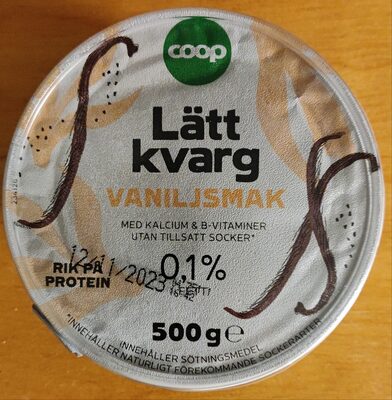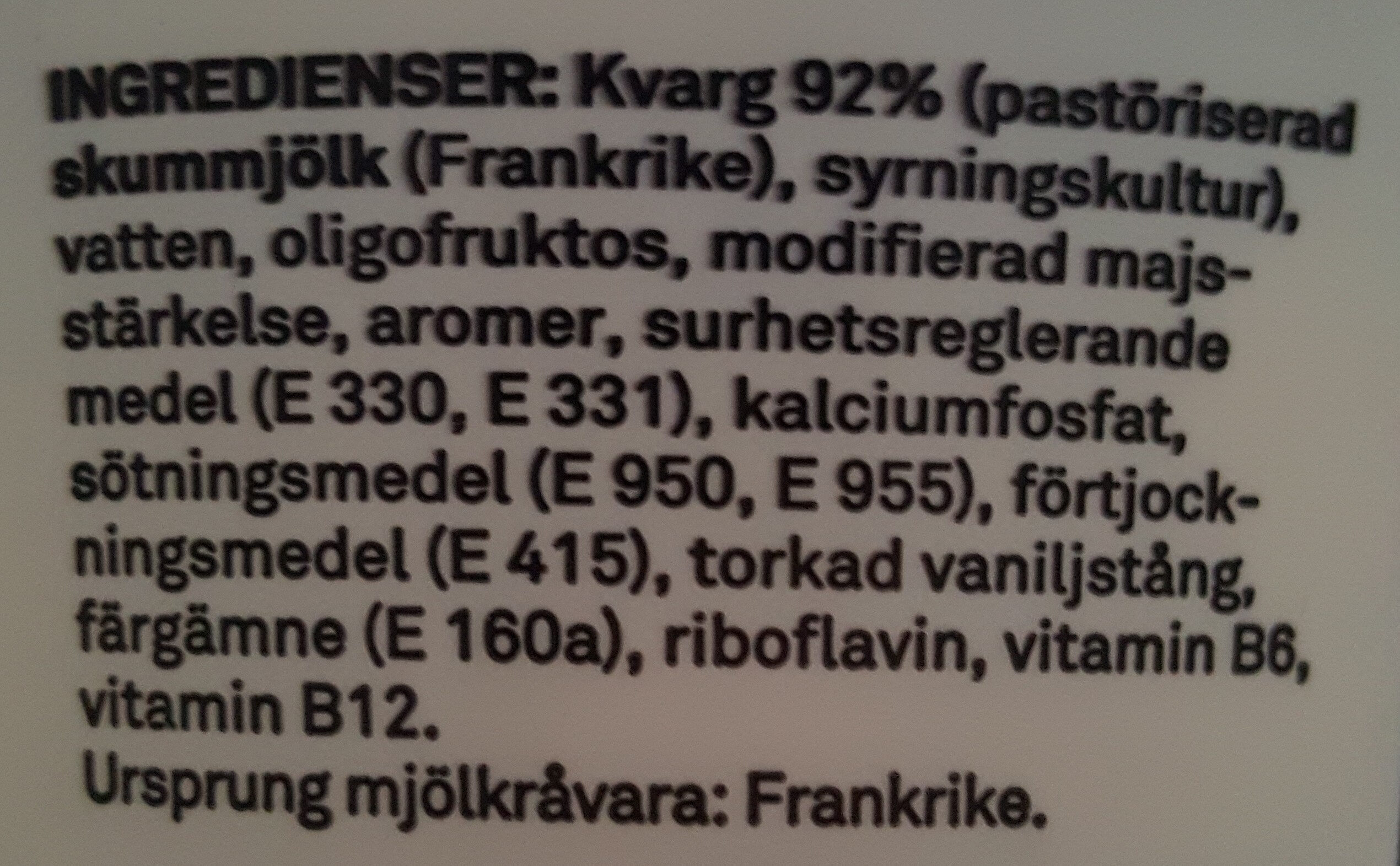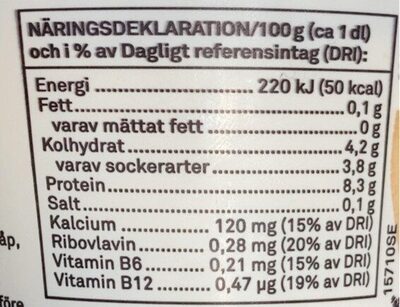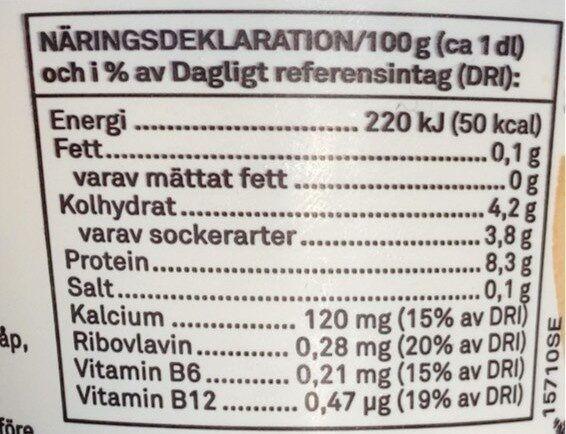Help us make food transparency the norm!
As a non-profit organization, we depend on your donations to continue informing consumers around the world about what they eat.
The food revolution starts with you!
Latt kvarg - Coop - 500g
Latt kvarg - Coop - 500g
This product page is not complete. You can help to complete it by editing it and adding more data from the photos we have, or by taking more photos using the app for Android or iPhone/iPad. Thank you!
×
Streckkod: 7300156507396 (EAN / EAN-13)
Kvantitet: 500g
Förpackning: Plast, en:pp-polypropylene
Varumärken: Coop
Kategorier: Mejeriprodukt, Fermenterad mat, Fermenterade mjölkprodukter, Ostar, Efterrätter, en:Dairy desserts, Kvarg, en:Cream cheeses, en:Lean quark
Ingredients ursprung: Frankrike
Tillverknings eller bearbetningsplats: France, Frankrike
Spårbarhetskod: FR 50.579.001 CE - Sottevast (Manche, France)
Butiker: Coop
Länder där såld: Sverige
Matching with your preferences
Hälsa
Ingredienser
-
22 ingredienser
Kvarg 92% (pastöriserad skummjölk (Frankrike), syrningskultur), vatten, oligofruktos, modifierad majsstärkelse, aromer, surhetsreglerande medel (E 330, E 331), kalciumfosfat, sötningsmedel (E 950, E 955), förtjockningsmedel (E 415), torkad vaniljstång, färgämne (E 160a), riboflavin, vitamin B6, vitamin B12.Allergener: Mjölk, Pastöriserad-skummjölk, Pastöriserad-skummjölk
Food processing
-
Ultra processed foods
Elements that indicate the product is in the 4 - Ultra bearbetade livsmedel och drycker group:
- Tillsats: E101 - Riboflavin
- Tillsats: E160a - Karoten
- Tillsats: E415 - Xantangummi
- Tillsats: E950 - Acesulfam k
- Tillsats: E955 - Sukralos
- Ingrediens: Färg
- Ingrediens: Arom
- Ingrediens: Sötningsmedel
- Ingrediens: Förtjockningsmedel
Food products are classified into 4 groups according to their degree of processing:
- Obearbetade eller minimalt bearbetade livsmedel
- Bearbetade kulinariska ingredienser
- Halvfabrikat
- Ultra processed foods
The determination of the group is based on the category of the product and on the ingredients it contains.
Tillsatser
-
E101 - Riboflavin
Riboflavin: Riboflavin, also known as vitamin B2, is a vitamin found in food and used as a dietary supplement. Food sources include eggs, green vegetables, milk and other dairy product, meat, mushrooms, and almonds. Some countries require its addition to grains. As a supplement it is used to prevent and treat riboflavin deficiency and prevent migraines. It may be given by mouth or injection.It is nearly always well tolerated. Normal doses are safe during pregnancy. Riboflavin is in the vitamin B group. It is required by the body for cellular respiration.Riboflavin was discovered in 1920, isolated in 1933, and first made in 1935. It is on the World Health Organization's List of Essential Medicines, the most effective and safe medicines needed in a health system. Riboflavin is available as a generic medication and over the counter. In the United States a month of supplements costs less than 25 USD.Källa: Wikipedia (Engelska)
-
E101i - Riboflavin
Riboflavin: Riboflavin, also known as vitamin B2, is a vitamin found in food and used as a dietary supplement. Food sources include eggs, green vegetables, milk and other dairy product, meat, mushrooms, and almonds. Some countries require its addition to grains. As a supplement it is used to prevent and treat riboflavin deficiency and prevent migraines. It may be given by mouth or injection.It is nearly always well tolerated. Normal doses are safe during pregnancy. Riboflavin is in the vitamin B group. It is required by the body for cellular respiration.Riboflavin was discovered in 1920, isolated in 1933, and first made in 1935. It is on the World Health Organization's List of Essential Medicines, the most effective and safe medicines needed in a health system. Riboflavin is available as a generic medication and over the counter. In the United States a month of supplements costs less than 25 USD.Källa: Wikipedia (Engelska)
-
E160a - Karoten
Carotene: The term carotene -also carotin, from the Latin carota, "carrot"- is used for many related unsaturated hydrocarbon substances having the formula C40Hx, which are synthesized by plants but in general cannot be made by animals -with the exception of some aphids and spider mites which acquired the synthesizing genes from fungi-. Carotenes are photosynthetic pigments important for photosynthesis. Carotenes contain no oxygen atoms. They absorb ultraviolet, violet, and blue light and scatter orange or red light, and -in low concentrations- yellow light. Carotenes are responsible for the orange colour of the carrot, for which this class of chemicals is named, and for the colours of many other fruits, vegetables and fungi -for example, sweet potatoes, chanterelle and orange cantaloupe melon-. Carotenes are also responsible for the orange -but not all of the yellow- colours in dry foliage. They also -in lower concentrations- impart the yellow coloration to milk-fat and butter. Omnivorous animal species which are relatively poor converters of coloured dietary carotenoids to colourless retinoids have yellowed-coloured body fat, as a result of the carotenoid retention from the vegetable portion of their diet. The typical yellow-coloured fat of humans and chickens is a result of fat storage of carotenes from their diets. Carotenes contribute to photosynthesis by transmitting the light energy they absorb to chlorophyll. They also protect plant tissues by helping to absorb the energy from singlet oxygen, an excited form of the oxygen molecule O2 which is formed during photosynthesis. β-Carotene is composed of two retinyl groups, and is broken down in the mucosa of the human small intestine by β-carotene 15‚15'-monooxygenase to retinal, a form of vitamin A. β-Carotene can be stored in the liver and body fat and converted to retinal as needed, thus making it a form of vitamin A for humans and some other mammals. The carotenes α-carotene and γ-carotene, due to their single retinyl group -β-ionone ring-, also have some vitamin A activity -though less than β-carotene-, as does the xanthophyll carotenoid β-cryptoxanthin. All other carotenoids, including lycopene, have no beta-ring and thus no vitamin A activity -although they may have antioxidant activity and thus biological activity in other ways-. Animal species differ greatly in their ability to convert retinyl -beta-ionone- containing carotenoids to retinals. Carnivores in general are poor converters of dietary ionone-containing carotenoids. Pure carnivores such as ferrets lack β-carotene 15‚15'-monooxygenase and cannot convert any carotenoids to retinals at all -resulting in carotenes not being a form of vitamin A for this species-; while cats can convert a trace of β-carotene to retinol, although the amount is totally insufficient for meeting their daily retinol needs.Källa: Wikipedia (Engelska)
-
E330 - Citronsyra
Citric acid: Citric acid is a weak organic acid that has the chemical formula C6H8O7. It occurs naturally in citrus fruits. In biochemistry, it is an intermediate in the citric acid cycle, which occurs in the metabolism of all aerobic organisms. More than a million tons of citric acid are manufactured every year. It is used widely as an acidifier, as a flavoring and chelating agent.A citrate is a derivative of citric acid; that is, the salts, esters, and the polyatomic anion found in solution. An example of the former, a salt is trisodium citrate; an ester is triethyl citrate. When part of a salt, the formula of the citrate ion is written as C6H5O3−7 or C3H5O-COO-3−3.Källa: Wikipedia (Engelska)
-
E331 - Natriumcitrater
Sodium citrate: Sodium citrate may refer to any of the sodium salts of citrate -though most commonly the third-: Monosodium citrate Disodium citrate Trisodium citrateThe three forms of the salt are collectively known by the E number E331. Sodium citrates are used as acidity regulators in food and drinks, and also as emulsifiers for oils. They enable cheeses to melt without becoming greasy.Källa: Wikipedia (Engelska)
-
E341 - Kalciumfosfater
Calcium phosphate: Calcium phosphate is a family of materials and minerals containing calcium ions -Ca2+- together with inorganic phosphate anions. Some so-called calcium phosphates contain oxide and hydroxide as well. They are white solids of nutritious value.Källa: Wikipedia (Engelska)
-
E415 - Xantangummi
Xanthan gum: Xanthan gum -- is a polysaccharide with many industrial uses, including as a common food additive. It is an effective thickening agent and stabilizer to prevent ingredients from separating. It can be produced from simple sugars using a fermentation process, and derives its name from the species of bacteria used, Xanthomonas campestris.Källa: Wikipedia (Engelska)
-
E950 - Acesulfam k
Acesulfame potassium: Acesulfame potassium - AY-see-SUL-faym-, also known as acesulfame K -K is the symbol for potassium- or Ace K, is a calorie-free sugar substitute -artificial sweetener- often marketed under the trade names Sunett and Sweet One. In the European Union, it is known under the E number -additive code- E950. It was discovered accidentally in 1967 by German chemist Karl Clauss at Hoechst AG -now Nutrinova-. In chemical structure, acesulfame potassium is the potassium salt of 6-methyl-1‚2,3-oxathiazine-4-3H--one 2‚2-dioxide. It is a white crystalline powder with molecular formula C4H4KNO4S and a molecular weight of 201.24 g/mol.Källa: Wikipedia (Engelska)
-
E955 - Sukralos
Sucralose: Sucralose is an artificial sweetener and sugar substitute. The majority of ingested sucralose is not broken down by the body, so it is noncaloric. In the European Union, it is also known under the E number E955. It is produced by chlorination of sucrose. Sucralose is about 320 to 1‚000 times sweeter than sucrose, three times as sweet as both aspartame and acesulfame potassium, and twice as sweet as sodium saccharin. Evidence of benefit is lacking for long-term weight loss with some data supporting weight gain and heart disease risks.It is stable under heat and over a broad range of pH conditions. Therefore, it can be used in baking or in products that require a long shelf life. The commercial success of sucralose-based products stems from its favorable comparison to other low-calorie sweeteners in terms of taste, stability, and safety. Common brand names of sucralose-based sweeteners are Splenda, Zerocal, Sukrana, SucraPlus, Candys, Cukren, and Nevella. Canderel Yellow also contains sucralose, but the original Canderel and Green Canderel do not.Källa: Wikipedia (Engelska)
Ingrediensanalys
-
Kan innehålla palmolja
Ingredienser som kan innehålla palmolja: E160a
-
Icke-vegan
Non-vegan ingredients: Kvarg, Pastöriserad skummjölk
-
Vegetarisk status okänd
Okända ingredienser: Kobalamin
-
Details of the analysis of the ingredients
: _Kvarg_ 92% (_pastöriserad skummjölk_, syrningskultur), vatten, oligofruktos, modifierad majsstärkelse, aromer, surhetsreglerande medel (e330, e331), kalciumfosfat, sötningsmedel (e950, e955), förtjockningsmedel (e415), vaniljstång, färgämne (e160a), riboflavin, vitamin B6, vitamin B12- _Kvarg_ -> en:quark - vegan: no - vegetarian: maybe - ciqual_proxy_food_code: 12999 - percent_min: 92 - percent: 92 - percent_max: 92
- _pastöriserad skummjölk_ -> en:pasteurized-skimmed-milk - vegan: no - vegetarian: yes - ciqual_food_code: 19051 - percent_min: 46 - percent_max: 92
- syrningskultur -> en:lactic-ferments - vegan: maybe - vegetarian: yes - percent_min: 0 - percent_max: 46
- vatten -> en:water - vegan: yes - vegetarian: yes - ciqual_food_code: 18066 - percent_min: 0.615384615384615 - percent_max: 8
- oligofruktos -> en:oligofructose - vegan: yes - vegetarian: yes - percent_min: 0 - percent_max: 7.38461538461539
- modifierad majsstärkelse -> en:modified-corn-starch - vegan: yes - vegetarian: yes - ciqual_food_code: 9510 - percent_min: 0 - percent_max: 3.69230769230769
- aromer -> en:flavouring - vegan: maybe - vegetarian: maybe - percent_min: 0 - percent_max: 2.46153846153846
- surhetsreglerande medel -> en:acidity-regulator - percent_min: 0 - percent_max: 1.84615384615385
- e330 -> en:e330 - vegan: yes - vegetarian: yes - percent_min: 0 - percent_max: 1.84615384615385
- e331 -> en:e331 - vegan: yes - vegetarian: yes - percent_min: 0 - percent_max: 0.923076923076923
- kalciumfosfat -> en:e341 - vegan: yes - vegetarian: yes - percent_min: 0 - percent_max: 1.47692307692308
- sötningsmedel -> en:sweetener - percent_min: 0 - percent_max: 1.23076923076923
- e950 -> en:e950 - vegan: yes - vegetarian: yes - percent_min: 0 - percent_max: 1.23076923076923
- e955 -> en:e955 - vegan: yes - vegetarian: yes - percent_min: 0 - percent_max: 0.615384615384616
- förtjockningsmedel -> en:thickener - percent_min: 0 - percent_max: 1.05494505494506
- e415 -> en:e415 - vegan: yes - vegetarian: yes - percent_min: 0 - percent_max: 1.05494505494506
- vaniljstång -> en:vanilla-pod - vegan: yes - vegetarian: yes - percent_min: 0 - percent_max: 0.923076923076923
- färgämne -> en:colour - percent_min: 0 - percent_max: 0.820512820512821
- e160a -> en:e160a - vegan: maybe - vegetarian: maybe - from_palm_oil: maybe - percent_min: 0 - percent_max: 0.820512820512821
- riboflavin -> en:e101 - vegan: maybe - vegetarian: yes - percent_min: 0 - percent_max: 0.820512820512821
- vitamin B6 -> en:vitamin-b6 - vegan: yes - vegetarian: yes - percent_min: 0 - percent_max: 0.671328671328672
- vitamin B12 -> en:vitamin-b12 - percent_min: 0 - percent_max: 0.671328671328672
- _Kvarg_ -> en:quark - vegan: no - vegetarian: maybe - ciqual_proxy_food_code: 12999 - percent_min: 92 - percent: 92 - percent_max: 92
Näring
-
Very good nutritional quality
⚠ ️Varning: mängden fibrer är inte angiven, eventuella positiv inverkan på betyget kunde inte beaktas.⚠ ️Warning: the amount of fruits, vegetables and nuts is not specified on the label, it was estimated from the list of ingredients: 0This product is not considered a beverage for the calculation of the Nutri-Score.
Positiva poäng: 5
- Proteiner: 5 / 5 (värde: 8.3000001907349, avrundat värde: 8.3)
- Fiber: 0 / 5 (värde: 0, avrundat värde: 0)
- Frukt, grönsaker, nötter och raps- / valnöt- / olivoljor: 0 / 5 (värde: 0, avrundat värde: 0)
Negativa poäng: 1
- Energi: 0 / 10 (värde: 220, avrundat värde: 220)
- Socker: 0 / 10 (värde: 3.7999999523163, avrundat värde: 3.8)
- Mättat fett: 0 / 10 (värde: 0, avrundat värde: 0)
- Natrium: 1 / 10 (värde: 112, avrundat värde: 112)
The points for proteins are counted because the negative points are less than 11.
Näringsvärde: (1 - 5)
Nutri-Score:
-
Näringsvärden
-
Fett i låg kvantitet (0.1%)
What you need to know- A high consumption of fat, especially saturated fats, can raise cholesterol, which increases the risk of heart diseases.
Recommendation: Limit the consumption of fat and saturated fat- Choose products with lower fat and saturated fat content.
-
Mättat fett i låg kvantitet (0%)
What you need to know- A high consumption of fat, especially saturated fats, can raise cholesterol, which increases the risk of heart diseases.
Recommendation: Limit the consumption of fat and saturated fat- Choose products with lower fat and saturated fat content.
-
Sockerarter i låg kvantitet (3.8%)
What you need to know- A high consumption of sugar can cause weight gain and tooth decay. It also augments the risk of type 2 diabetes and cardio-vascular diseases.
Recommendation: Limit the consumption of sugar and sugary drinks- Sugary drinks (such as sodas, fruit beverages, and fruit juices and nectars) should be limited as much as possible (no more than 1 glass a day).
- Choose products with lower sugar content and reduce the consumption of products with added sugars.
-
Salt i låg kvantitet (0.28%)
What you need to know- A high consumption of salt (or sodium) can cause raised blood pressure, which can increase the risk of heart disease and stroke.
- Many people who have high blood pressure do not know it, as there are often no symptoms.
- Most people consume too much salt (on average 9 to 12 grams per day), around twice the recommended maximum level of intake.
Recommendation: Limit the consumption of salt and salted food- Reduce the quantity of salt used when cooking, and don't salt again at the table.
- Limit the consumption of salty snacks and choose products with lower salt content.
-
-
Näringsfakta
Näringsfakta Som såld
för 100 g / 100 mlCompared to: en:Lean quark Energi 220 kj
(50 kcal)−11 % Fett 0,1 g −44 % Mättat fett 0 g Kolhydrat 4,2 g +5 % Sockerarter 3,8 g +4 % Fiber ? Protein 8,3 g −13 % Salt 0,28 g Vitamin B6 0,28 mg Vitamin B12 (cobalamin) 0,47 µg Kalcium 120 mg Fruits‚ vegetables‚ nuts and rapeseed‚ walnut and olive oils (estimate from ingredients list analysis) 0 %
Miljö
-
Eco-Score C - Måttlig miljöpåverkan
The Eco-Score is an experimental score that summarizes the environmental impacts of food products.→ The Eco-Score was initially developped for France and it is being extended to other European countries. The Eco-Score formula is subject to change as it is regularly improved to make it more precise and better suited to each country.Life cycle analysis
-
Average impact of products of the same category: C (Score: 54/100)
Kategori: Camembert cheese, from cow's milk
Kategori: Camembert cheese, from cow's milk
- PEF environmental score: 0.50 (the lower the score, the lower the impact)
- including impact on climate change: 5.24 kg CO2 eq/kg of product
Stage Impact Jordbruk
84.4 %Bearbetar
5.6 %Förpackning
4.4 %Transportation
3.3 %Distribution
1.8 %Consumption
0.5 %
Bonuses and maluses
-
Origins of ingredients with a medium impact
Bonus: +6
Environmental policy: +4
Transportation: +2
Origin of the product and/or its ingredients % of ingredients Impact Frankrike 100 %Medium
-
Packaging with a medium impact
Malus: -8
Form Material Återvinning Impact Okänd PP 5 - polypropen Hög ⚠ ️ The information about the packaging of this product is not sufficiently precise (exact shapes and materials of all components of the packaging).⚠ ️ For a more precise calculation of the Eco-Score, you can modify the product page and add them.
If you are the manufacturer of this product, you can send us the information with our free platform for producers.
Eco-Score for this product
-
Impact for this product: C (Score: 52/100)
Produkt: Latt kvarg - Coop - 500g
Life cycle analysis score: 54
Sum of bonuses and maluses: -2
Final score: 52/100
-
Carbon footprint
-
Equal to driving 2.7 km in a petrol car
524 g CO² per 100g of product
The carbon emission figure comes from ADEME's Agribalyse database, for the category: Camembert cheese, from cow's milk (Source: ADEME Agribalyse Database)
Stage Impact Jordbruk
85.1 %Bearbetar
5.0 %Förpackning
5.0 %Transportation
4.0 %Distribution
0.7 %Consumption
0.1 %
Förpackning
-
Packaging with a medium impact
-
Packaging parts
(PP 5 - polypropen)
-
Packaging materials
Material % Packaging weight Packaging weight per 100 g of product Plast
-
Transportation
-
Origins of ingredients
Origins of ingredients with a medium impact
Origin of the product and/or its ingredients % of ingredients Impact Frankrike 100 %Medium
Report a problem
-
Incomplete or incorrect information?
Category, labels, ingredients, allergens, nutritional information, photos etc.
If the information does not match the information on the packaging, please complete or correct it. Open Food Facts is a collaborative database, and every contribution is useful for all.
Datakällor
Produkt tillagd den av akitainu
Senast ändrad produktsida på av akitainu.
Produktsida också redigerad av ecoscore-impact-estimator, jumati, kiliweb, openfoodfacts-contributors, packbot, yuka.sY2b0xO6T85zoF3NwEKvlk1GcMj5kCvKOB_5hFyy7_iqf7ruYeNixKj6Lqs.









